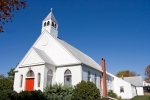July 2018
Creative Communications
Creating a Visual Identity for the Episcopal Church, Step-by-Step
Before beginning to create the Visual Identity Guide for the Episcopal Church, I needed to find the tone or “look and feel” of the Church. To learn this, I watched loads of Michael Curry sermons. Keywords such as courageous, bold, fun and colorful came to mind. I made a list of many other keywords that reflect the spirit of those sermons.
A keyword list is a first step in the important process of developing an identity system for your congregation or diocese. The list of keywords that you develop will drive the process. Make sure your words are strong, lively and authentic.
Build a mood board that reflects the look and feel of your congregation or diocese
From the list of keywords, I began work on a mood board to show visually what these words might look like. You can create a mood board old school style with magazine clippings, scissors and glue, or you can pull online images and ideas and build it digitally. Make the board at least 17” x 11,” so you can hang it up and refer to it during the design process. I looked at other identity systems that stressed courage, such as the Olympics from 1968 and 1984, and other non-profits that are bold and colorful, like Girl Scouts and World Conservation Society. Then I added book covers, poster designs and other images that represented a fun spirit.
Assemble all the images you collect in a collage or grid, 15-20 per page. Have your team pick one board that is the most successful in telling the story of your identity visually. You may have to take parts of each to make a new final mood board. Keep referring to it to help you make decisions as you move along to the next steps.
Design: Start with what you have and move on to typography and color
Next, I looked over what already existed in the church’s identity, like the logo. This is a good place to start. Our logo needed a little freshening up, so I removed the gradient and updated the typeface, rendering it more modern and giving the typography some context. The type chosen should have some meaning, and I chose Garamond for the serif. It’s highly accessible and in the same lineage as the original typeface used for the Book of Common Prayer. Gill sans was chosen for the sans serif. It pairs excellently with Garamond in overall stature and is also the typeface of the Church of England. A serif and a sans serif typeface will give you more flexibility in creating many voices and moods with your identity.
The color palette is core to bringing all the elements together in a cohesive way. Because bold and colorful were my keywords and not somber and quiet, the choices were obvious. Bright, earthy tones were chosen. The two primary colors of the Church were red and blue from our shield. The bright, secondary colors were orange, green, yellow, light blue and purple. A secondary color palette offers greater flexibility, enabling designers to create individualized looks for different campaigns or organizations while still keeping the look in the family.
This color exploration brought me to the many missions inside the Episcopal Church. There needed to be a system that gave each mission its own identity, while keeping them all in the family. I used color to give them an individual look. The head of each mission was asked what color best represented its work. From there, I made sure the colors looked like a family by trying to keep the mission mark colors in the warm temperature range. The self-appointed colors became each mission’s individual identity inside of the Church and could be used as an easily recognizable main ingredient in layouts, presentations and ads. The Episcopal Church shield locks-up within each mission mark to make the connection to the Church immediate.
Keep it real with photos
One thing that stood out to me as a striking aspect of the Episcopal Church were the photographs I’d seen of Episcopalians in action. Real people in real situations — attending a service, making sandwiches for the homeless, marching for a cause, giving ashes out on the street. Images like these speak volumes. That’s when I decided that stock photos were out. The Episcopal Church is about real people in action and on the move. We needed images from real cameras, not phone cameras, that were high resolution and print ready. To do that, we are building a library of high resolution images captured at revivals and other events to help tell our story with real people — and with their permission.
Something I learned from working with many different style guides in my career is that the more rules you have, the more difficult it is to do your job. Flexibility and a DIY spirit were necessary to empower congregations of different sizes to use this identity guide. That is why I kept it simple and short, just a few basic directions and a solid core of typography and color. We wanted to help people to make design decisions and keep the look of the Episcopal Church similar in spirit and voice across the world.
View the guide here.
Melissa Walker is the Senior Graphic Designer on the Presiding Bishop’s staff. She created the successful Visual Identity Guide for the Episcopal Church, creating a new look for the Church’s identity. Melissa holds a Bachelor of Arts degree in Graphic Design from the Academy of Art University in San Francisco, California. In her spare time, she collects original vinyl records and travels the world for design inspiration.
Resources:
- 15-Minute Marketing: from Picture to Postcard by Richelle Thompson, ECF Vital Practices Blog, April 30, 2012
- Marketing 101 by Peter Strimer, ECF Vital Practices Blog, May 19, 2011
- TEC’s Visual Identity Guide
- Canva: Free digital mood board generator






